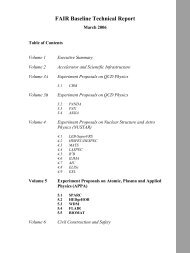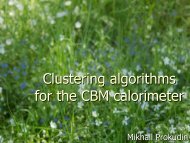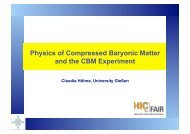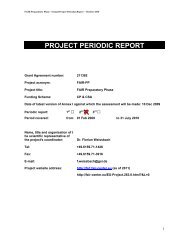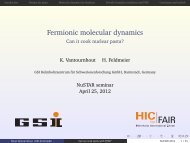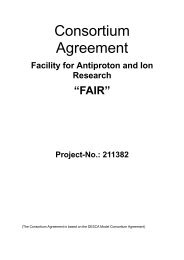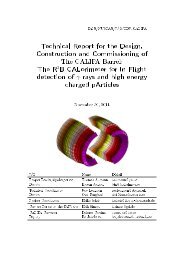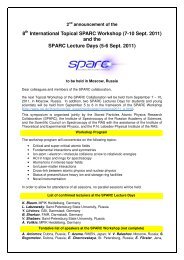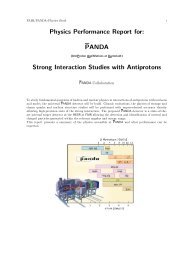NeuLAND - FAIR
NeuLAND - FAIR
NeuLAND - FAIR
You also want an ePaper? Increase the reach of your titles
YUMPU automatically turns print PDFs into web optimized ePapers that Google loves.
events<br />
1200<br />
1000<br />
800<br />
600<br />
400<br />
200<br />
σ = 17 keV<br />
0<br />
0 500 1000<br />
E (keV)<br />
rel<br />
Figure B.8.: Reconstructed relative energy spectrum for the Neutron MRPC from a<br />
Monte Carlo simulation. Simulated is the one-neutron emission from 132 Sn<br />
for 600 AMeV energy with a relative energy of 100 keV. The detector is<br />
placed at 35 m distance to the target.<br />
In order to be able to reconstruct the relative energy, an algorithm was developed, which<br />
selects those hits in the simulation that can be used to determine the momenta of the<br />
incoming neutrons correctly. The hit multiplicity increases as the number of impinging<br />
neutrons increases and there is a fair separation between the appearing peaks in the<br />
spectrum as is seen in figure B.7. Therefore, this was used to determine the number of<br />
incoming neutrons in an event (n). This provides us the so-called identification matrix<br />
which contains correlation percentages between the expected and deduced number of<br />
incoming neutron (see e.g., B.1). The hit selection algorithm is based on the clustering<br />
of the hits with an adjustable distance parameter, which is combined with a causality<br />
check between the clusters. The remaining hits were ordered according to their latent<br />
speed calculated from the hit position and time of detection. The first n number of hits<br />
were used for the momentum and relative energy reconstruction. As an example such a<br />
reconstructed relative energy spectrum is shown in figure B.8.<br />
According to the simulations, the MRPC-based setup is able to detect single neutrons<br />
with high efficiency. There is some limited capability, as well, to disentangle multineutron<br />
events and reconstruct the relative energy of nuclear reaction products. The<br />
multi-neutron performance is, however, much worse than that of the scintillator-based<br />
concept (see section 4.5).<br />
109





